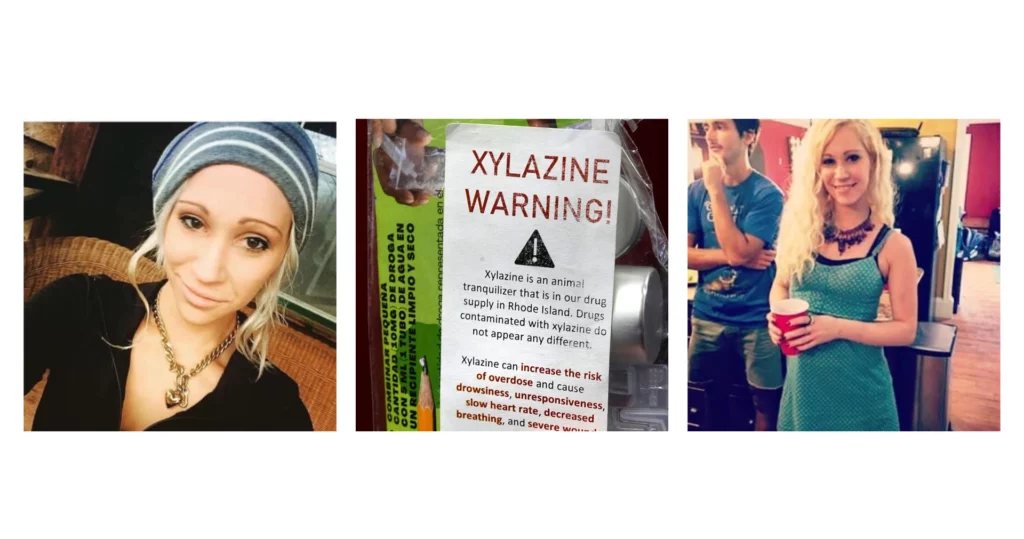Content Advisory Warning: The following content and images portray sensitive and potentially triggering subjects. Kelsey shares about her childhood trauma and the current state of her addiction, including graphic photos of wounds related to Tranq use. Please exercise caution when reading and viewing.
FAIRFAX, VA – Kelsey was once on a path to a bright future, showcasing remarkable talent as a field hockey player and consistently taking home top honors at dog shows across the country as an extraordinary dog handler and groomer.
However, her life has taken a devastating turn due to her addiction to Tranq.
Tranq is a mixture of Fentanyl and Xylazine, starting to spread rapidly across America.
Dealers are cutting Fentanyl with Xylazine to increase profits; it’s a way to bulk up the amount of product and provide a more potent high.
Kelsey Miller has lost a portion of her left hand and faces the bleak reality of losing her legs due to gaping wounds.
Adding to her crisis, she is desperate for treatment but is being denied by treatment centers on the East Coast due to the severity of her wounds.
This article highlights the grave risks and life-altering repercussions of addiction to Tranq while bringing awareness to Kelsey’s story.

Kelsey Miller’s Story
“I’m going to lose my legs because of Tranq!”
In a candid conversation, I sat down with my good friend Kelsey Miller, a 31-year-old woman battling Tranq addiction.
The consequences of her addiction are palpable: she is on the brink of having her legs amputated due to the severe wounds attributed to her drug use.
The physical reminders of her ordeal are evident – she lost her hand in 2021.
Yet, the societal response to her condition seems to compound her pain; she is repeatedly denied the critical addiction treatment she so desperately seeks because of her Tranq wounds.
As many turn a blind eye, treating her as a discarded memory, Kelsey’s narrative is one of struggle, resilience, and a plea for help and understanding.
This is her story.

Kelsey’s Upbringing
Childhood and Early Life
Q: Can you briefly describe your background and childhood?
A: “I grew up in Northern Virginia, where I still live today. As a kid, I often felt alone because my family was always on the road for my mom’s dog shows. Even though I was super young, around 5 or 6, I started joining in and showing dogs myself, and surprisingly, I started winning a lot! But I wasn’t always doing it because I loved it; sometimes, I just wanted to make my parents happy. I also played field hockey, which I liked and was good at. I’m proud to say that I made it onto the Varsity Field Hockey team. But I missed just hanging out with friends on weekends like other kids. Traveling so much meant I didn’t get to do that. I also wished I was closer to my big sister, but she seemed distant and closed off like she didn’t want to hang out with me. Feeling this way, wanting my parents to be proud of me, and feeling lonely made it easier for me to get into trouble with drugs.”
First Contact with Drugs
Q: Can you tell us about how you started using drugs?
A: “When I was around 13 or 14, I was groomed and sexually abused by a trusted family friend at the dog shows. It hurt even more when people didn’t believe me. Feeling alone and hurt, I started using Oxycontin, which I got from a guy I knew up the street. The family friend who was sexually abusing me even gave me money to buy it, thinking he could buy my silence. But the pills were expensive, so I began using heroin. At first, I snorted it, but later, I started injecting it daily. By age 15, I was a full-blown (intravenous) heroin addict.”
How I Started Using Tranq
First Contact with Tranq
Q: How did you first come across Tranq?
A: “In 2020, I found out about a drug called Tranq. I didn’t mean to try it and even avoided it at first. When I went to Baltimore to buy cheaper drugs, I noticed Tranq was getting popular there. It was easy to spot because it usually came in capsules. So, I tried to buy from other dealers who didn’t have it. But, the dealers got sneaky and started putting Tranq in regular bags, essentially tricking us into buying the Tranq. Over time, real heroin has become non-existent, and now, most people are selling and using Tranq dope, a mix of Fentanyl and Xylazine.”
Comparing Different Substances
Q: How Does Tranq compare to other drugs?
A: “Tranq has been the most challenging drug for me to quit, both in terms of its physical and mental hold on me. Just consider where I am now: I’ve lost a hand and am at risk of losing my legs, yet the grip of this addiction remains strong. And it’s not an isolated issue. Right now, countless others are battling the same addiction. There’s a pressing need for action, especially when many of us are denied access to treatment centers because of the severity of our Tranq wounds. This is a really dangerous drug, and things are only getting worse. We’re in a dire situation.”
Frequency of Use & Tolerance
Q: How often do you use Tranq, and has the frequency changed over time?
A: “Daily, and multiple times within that day. As is typical with addiction, a tolerance develops.. and I have to do more to get the same effect. About 4 hours after using it starts to wear off, and I need more and have to use it again. I barely even get high anymore… It’s just to fight off the withdrawals. I start feeling sick fast, and I am terrified of how bad I will feel if I don’t have anymore.”
Attempts to Quit or Lessen Amount
Q: Have you attempted to quit or lessen your use of Tranq? How did that work out?
A: “Yes, I’ve tried, but with little success. Tackling any addiction is challenging, but it becomes even more complicated when the drug’s effects wear off within a few hours and you’re in agony from withdrawals. I’ve always been impulsive, so tapering or decreasing my use is challenging. Sometimes, I made progress for a day or two, but I’d fall back even harder whenever I had some cash. I want to add that I go to a MAT clinic and currently take Methadone, and even with a high dosage, I still feel terrible and experience withdrawals when not using Tranq. That is how powerful this drug is; it is scarily powerful.”
Physical and Mental Effects of Tranq Withdrawal
Q: Can you describe the withdrawal symptoms from Tranq?
A: “I once believed heroin withdrawal was the epitome of suffering until I experienced withdrawal from Fentanyl, which was overwhelmingly miserable. But Xylazine surpasses them both by miles. The symptoms start about 4 hours after your last use and come on very fast. Physically, I have intense sweating, shaking, diarrhea, and terrible nausea, leading to violent vomiting. Mentally, it pushes me to a breaking point, where I have thought about ending my life to make the suffering stop. Once you experience the withdrawals of this stuff, you will do anything, no matter what, to never let yourself become sick again!”
Risk of Overdose and Death
Q: Have you experienced an overdose, and if so, what happened afterward?
A: “Yes, I’ve overdosed multiple times, even quite recently. I’ve been given Narcan on several occasions. It’s hard to admit, but I’ve often returned to getting high after regaining consciousness from these overdoses. That is the insanity of addiction! I find myself so deep in my addiction that even after a near-death experience, I go right back to the drug that almost killed me! People must understand that addiction is a mental health issue—I’m struggling with a disease that essentially wants me dead. What I need, instead of ridicule and judgment, is help! All I want is to get better and not live like this.”
Physical and Health Impacts
Long-Term Consequences
Q: How has your addiction affected your physical health and overall well-being?
A: “In 2021, I suffered a devastating loss: my left hand, which had to be amputated because of a severe infection that turned to gangrene. I am left-handed, too, so I lost my dominant hand. I have had to relearn everything all over again, and I am still learning. As a result, I lost my ability to groom dogs, which was my source of income, and I even had my own business.”
The Progression of Kelsey’s Tranq Sores
Beginning of Sores
Q: Can you explain when you first noticed your wounds and how they relate to your use of Tranq?
A: “When I first noticed these small, abscess-like sores, I thought they might have been due to missed injections. I didn’t connect them with Xylazine until news broke about wounds and amputations being related to Tranq. I won’t lie; honestly, I shot up (injected) in my legs and wherever I could find a vein, and still do. I thought the abscesses resulted from missing my hits (injections). However, those small abscesses became larger, infected, and extremely painful. Before I knew it, they merged into one big, painful sore. It was just a traumatic experience, and now I’m facing the terrifying prospect of the same thing happening to my legs. They have open, painful wounds that get re-infected, causing pus to ooze out. Multiple hospital stays have become the norm for me, where I’m treated for serious infections like sepsis and MRSA. The impact of ‘ Tranq’ is overwhelming, reshaping not just my physical appearance, but also deeply affecting my mental state.”
Current Condition of Tranq Sores
Q: What is the current condition of your wounds, and how is it affecting you?
A: “It’s really hard for me to discuss this, and I regret letting it reach this point. My legs, particularly below the knees, are in really bad shape, and there’s a real threat of amputation. The reason? Injecting Tranq. The pain and swelling make even simple tasks, like walking, almost unbearable. The wounds frequently leak pus and other liquids, and any accidental nudge against furniture can cause them to tear open and bleed profusely. The unending pain and recurring infections send me to the hospital quite often. Regrettably, despite the state of my legs, I continue to use Tranq (Xylazine), perpetuating this vicious cycle. Doctors aren’t offering pain relief for my condition, so I’m left with self-medicating. The fear of going through withdrawals is paralyzing. This situation has made me highly dependent, particularly on my parents, amplifying my guilt and burden. Some days, I want to die, because I feel like things will never get better.”
Support & Wound Management
Q: What kind of support, if any, do you currently have in managing your sores/wounds?
A: “Currently, I’m enrolled in a wound care program where professionals visit my home weekly to dress my wounds and provide me with supplies for self-care. While this assistance is beneficial, it feels insufficient. My persistent leg pain, stemming from inadequate pain management, drives me to self-medicate with drugs that invariably contain Xylazine. This only exacerbates the wound situation, making them more severe and prone to infections. And when I seek additional help or treatment, my wounds often become why I’m turned away, leaving me feeling trapped in a cycle of despair.”
Medical and Hospital Treatments
Q: How have you been treated during your hospital stays?
A: “I’ve sought medical help on several occasions. I’ve battled sepsis about four times and MRSA twice, resulting in hospital stays of roughly a month each time, where I was continually administered IV antibiotics. The situation was so dire; that my mother began preparing for my funeral, even discussing cremation options. During my hospitalization, my legs began to show signs of healing. Yet, upon my release, I was given no pain management support. While in the hospital, I was on morphine to manage the excruciating pain from my wounds. Transitioning from that level of care to none led me to relapse as I attempted to self-medicate the unbearable pain. The hospital experience wasn’t devoid of challenges either; I encountered several judgmental nurses who implied that I “brought this upon myself” because of my addiction. Their lack of compassion and understanding felt like a punishment. While there were some compassionate nurses, the negative experiences with a few significantly marred my overall hospital stay, making it a traumatic period.”


